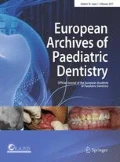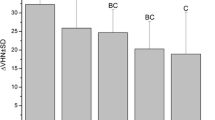Abstract
Aim
This in vitro investigation was to evaluate the fluoride release and recharge abilities of three recently introduced dental fissure sealants (FS).
Methods
Three dental FS were assessed: Teethmate F-1 (Kuraray), Fissurit F (Voco), BeautiSealant (Shofu), and a conventional glass ionomer cement FX-II (Shofu) as a control. Eight cylindrical specimens (7 × 2 mm) of each material were made and immersed individually in 5 ml de-ionized water in plastic containers. Fluoride release of the tested materials was evaluated during the experimental period (28 days) utilising a fluoride ion-selective electrode. At the end of the test period, the specimens were soaked for 5 min in a fluoride solution (0.05 % NaF) and fluoride release was evaluated for the next 5 days. The data were statistically analysed using one-way ANOVA and Bonferroni post hoc test and the level of significance was preset at α = 0.05.
Results
The total fluoride release over the 28-day period for each material was: FX-II (408.6 ± 45.66 μg/cm2) > Teethmate F-1 (89.45 ± 12.32 μg/cm2) > Fissurit F (68.62 ± 8.72 μg/cm2) > BeautiSealant (33.32 ± 4.91 μg/cm2), (p < 0.05). After the re-fluoridation of the specimens with 0.05 % NaF solution the cumulative fluoride re-release during the 5-day period for each material was: FX-II (99.53 ± 13.21 μg/cm2) > Teethmate F-1 (9.76 ± 1.62 μg/cm2) > BeautiSealant (5.69 ± 0.89 μg/cm2) > Fissurit F (4.76 ± 0.72 μg/cm2), (p < 0.05).
Conclusions
The three tested sealants exhibited different capabilities to release and uptake fluoride ions after re-fluoridation but significantly lower than the glass ionomer tested.




Similar content being viewed by others
References
Azarpazhooh A, Main PA. Pit and fissure sealants in the prevention of dental caries in children and adolescents: a systematic review. J Can Dent Assoc. 2008;74:171–7.
Beauchamp J, Caufield PW, Crall JJ, et al. Evidence-based clinical recommendations for the use of pit-and-fissure sealants: a report of the American Dental Association Council on Scientific Affairs. J Am Dent Assoc. 2008;139:257–68.
Bell A, Creanor SL, Foye RH, Saunders WP. The effect of saliva on fluoride release by a glass-ionomer filling material. J Oral Rehabil. 1999;26:407–12.
Bertacchini SM, Abate PF, Blank A, Baglieto MF, Macchi RL. Solubility and fluoride release in ionomers and compomers. Quintessence Int. 1999;30:193–7.
Choudhary P, Tandon S, Ganesh M, Mehra A. Evaluation of the remineralization potential of amorphous calcium phosphate and fluoride containing pit and fissure sealants using scanning electron microscopy. Indian J Dent Res. 2012;23:157–63.
Czarnecka B, Limanowska-Shaw H, Nicholson JW. Buffering and ion-release by a glass-ionomer cement under near-neutral and acidic conditions. Biomaterials. 2002;23:2783–8.
Dionysopoulos D. The effect of fluoride-releasing restorative materials on inhibition of secondary caries formation. Fluoride. 2014;47:258–65.
Dionysopoulos P, Kotsanos N, Pataridou A. Fluoride release and uptake by four new fluoride releasing restorative materials. J Oral Rehabil. 2003;30:866–72.
Dionysopoulos D, Koliniotou-Koumpia E, Helvatzoglou-Antoniades M, Kotsanos N. Fluoride release and recharge ability of contemporary fluoride-containing restorative materials and dental adhesives. Dent Mater J. 2013;32:296–304.
Fan Y, Townsend J, Wang Y, et al. Formulation and characterization of antibacterial fluoride-releasing sealants. Pediatr Dent. 2013;35:13–8.
FDI Commission. Mouthrinses and dental caries. Int Dent J. 2002;52:337–45.
Garcia-Godoy F, Abarzua I, De Goes MF, Chan DC. Fluoride release from fissure sealants. J Clin Pediatr Dent. 1997;22:45–9.
Han L, Cv E, Li M, et al. Effect of fluoride mouth rinse on fluoride releasing and recharging from aesthetic dental materials. Dent Mater J. 2002;21:285–95.
Hatibovic-Kofman S, Koch G, Ekstrand J. Glass ionomer materials as a rechargeable fluoride-release system. Int J Paediatr Dent. 1997;7:65–73.
Hayacibara MF, Ambrozano GM, Cury JA. Simultaneous release of fluoride and aluminum from dental materials in various immersion media. Oper Dent. 2004;29:16–22.
Hicks MJ, Flaitz CM, Garcia-Godoy F. Fluoride-releasing sealant and caries-like enamel lesion formation in vitro. J Clin Pediatr Dent. 2000;24:215–9.
Ikemura K, Tay FR, Endo T, Pashley H. A review of chemical-approach and ultramorphological studies on the development of fluoride-releasing dental adhesives comprising new pre-reacted glass ionomer (PRG) fillers. Dent Mater J. 2008;27:315–39.
Itota T, Carrick TE, Yoshiyama M, McCabe JF. Fluoride release and recharge in giomer, compomer and resin composite. Dent Mater. 2004;20:789–95.
Kantovitz KR, Pascon FM, Correr GM, et al. Influence of environmental conditions on properties of ionomeric and resin sealant materials. J Appl Oral Sci. 2009;17:294–300.
Kavaloglou Cildir S, Sandalli N. Compressive strength, surface roughness, fluoride release and recharge of four new fluoride-releasing fissure sealants. Dent Mater J. 2007;26:335–41.
Kosior P, Kaczmarek U. Short term fluoride release from conseal F fissure sealant in some media—an in vitro study. Ann Acad Med Stetin. 2006;52:61–5.
Kuşgöz A, Tüzüner T, Ulker M, Kemer B, Saray O. Conversion degree, microhardness, microleakage and fluoride release of different fissure sealants. J Mech Behav Biomed Mater. 2010;3:594–9.
Marks D, Owens BM, Johnson WW. Effect of adhesive agent and fissure morphology on the in vitro microleakage and penetrability of pit and fissure sealants. Quintessence Int. 2009;40:763–72.
Mejàre I, Lingström P, Petersson LG, et al. Caries-preventive effect of fissure sealants: a systematic review. Acta Odontol Scand. 2003;61:321–30.
Papacchini F, Goracci C, Sadek FT, et al. Microtensile bond strength to ground enamel by glass-ionomers, resin-modified glass-ionomers, and resin composites used as pit and fissure sealants. J Dent. 2005;33:459–67.
Rajtboriraks D, Nakornchai S, Bunditsing P, Surarit R, Iemjarern P. Plaque and saliva fluoride levels after placement of fluoride releasing pit and fissure sealants. Pediatr Dent. 2004;26:63–6.
Shen C, Shokry TE, Anusavice KJ. Influence of pH and oxygen-inhibited layer on fluoride release properties of fluoride sealant. J Dent. 2007;35:275–81.
Shimazu K, Ogata K, Karibe H. Evaluation of the ion-releasing and recharging abilities of a resin-based fissure sealant containing S-PRG filler. Dent Mater J. 2011;30:923–7.
Twetman S, Petersson LG, Axelsson S, et al. Caries preventive effect of sodium chloride mouthrinses: a systematic review of controlled clinical trials. Acta Odontol Scand. 2004;62:223–30.
Ulukapi H, Benderli Y, Soyman M. Determination of fluoride release from light-cured glass-ionomers and a fluoridated composite resin from the viewpoint of curing time. J Oral Rehabil. 1996;23:197–201.
Wiegand A, Buchalla W, Attin T. Review on fluoride-releasing restorative materials-Fluoride release and uptake characteristics, antibacterial activity and influence on caries formation. Dent Mater. 2007;23:343–62.
Williams JA, Billington RW, Pearson GJ. The influence of sample dimensions on fluoride ion release from a glass ionomer restorative cement. Biomaterials. 1999;20:1327–37.
Zhou SL, Zhou J, Watanabe S, et al. In vitro study of the effects of fluoride-releasing dental materials on remineralization in an enamel erosion model. J Dent. 2012;40:255–63.
Author information
Authors and Affiliations
Corresponding author
Rights and permissions
About this article
Cite this article
Dionysopoulos, D., Sfeikos, T. & Tolidis, K. Fluoride release and recharging ability of new dental sealants. Eur Arch Paediatr Dent 17, 45–51 (2016). https://doi.org/10.1007/s40368-015-0200-1
Received:
Accepted:
Published:
Issue Date:
DOI: https://doi.org/10.1007/s40368-015-0200-1



